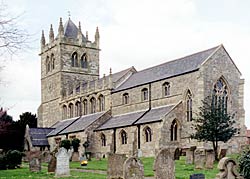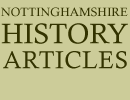Laxton
 Laxton church.
Laxton church.Not far from Ossington, on the Retford side, is the pleasant village of Laxton, or Lexington, which, though possessing few features of antiquarian interest to-day, may truly be said to be an historic village. What an eminent list of owners it has had, and what famous men have borne to the forefront the honoured name of Lexington! For a century after the Conquest the manor was owned by stalwart men of Norman descent, bearing the name De Cauz, of whom Robert, a baron of the time of Henry II., made Laxton the site of his principal mansion and head of his barony. From this family it passed by the marriage of Matilda de Cauz to the Birkins and thence to the Everinghams, who were amongst the most powerful and warlike nobles of their day. Adam de Everingham, temp. Henry III., took up arms with Simon de Montfort, Earl of Leicester, and fought at the battle of Evesham. His grandson, Adam, was a still more famous soldier, for he accompanied Prince Edward throughout the Scottish wars, and was created Knight of the Bath. On the accession of the Prince as Edward II., he was summoned to Parliament as a baron, and remained high in the Royal favour until he rebelled and became a partisan of Thomas Earl of Lancaster. At the battle of Boroughbridge he was taken prisoner, and had to pay a heavy fine to save his life. The village saw a good deal of him, for it waa his principal seat, and when he died he made it entailed property, with a view of preserving it in the Everingham family. The manor was holden of the Archbishop of York by the service of performing the office of butler in the prelate's housf on the day of his enthronisation. Under this curious tenure it passed to another Adam de Everingham, who was summoned to Parliament as "Adam de Everingham de Laxton," on the 8th January, 1371. Like his predecessors, he was a brave soldier, and left the quietude of his house at Laxton to participate in the glories of Cressy. On his demise, in 1371, he was succeeded by his grandson, who died without issue, and the barony fell into abeyance (1).
Such were a few of the noble owners, whom the good people of Laxton, down to the latter part of the fourteenth century, had resident in their midst. How they would watch the mail-clad barons riding from the village in response to duty's call, and what rejoicings there would be on the return of Lord Adam from the famous war in France ! We might stay long musing on the scenes which Laxton would witness as the home of a brave and dauntless race of warriors, but we pass on to mention other great men who did it equal, if not greater, honour. In the days of King John, when Matilda de Cauz was lady of the manor, the principal tenant or custodian of the lands was Richard de Lexington, whose three sons, taking-their names, as their ancestors had done, from the place of their birth, rose to great eminence. Robert de Lexington became a judge, John de Lexington was also a judge and a soldier, and Henry de Lexington was made Bishop of Lincoln. The name again came to the forefront in 1645, when Robert Sutton, of Averham, a descendant of the Lexington family, was elevated to the peerage by the title of Baron Lexington, of Averham. After the days of the Evering-hams the ownership of the manor became vested in the family of Roos, with whom it remained until the middle of the seventeenth century, when Bridgett, only daughter and heiress of Robert Roos, of Ingmanthorp, "by her own misfortunes and the wicked unthriftiness of her son Gilbert, the last Lord of Laxton of this noble race, was reduced to so great poverty that she gleaned corn amongst the poor people in Laxton fields."
The old church, in which some of these distinguished people often worshipped, was a large building in the decorated style, erected no doubt when the Everinghams were at the zenith of their wealth and power. It had a spacious nave and two side aisles, with a large chancel and a lofty tower. There was a chauntry in the church and many memorials of departed worthies. Thoroton saw there in his day on an alabaster tomb on the south side of the choir, an effigy bearing the arms of Everingham, while the windows were filled with heraldic glass to the families of Everingham, Roos, D'Eivil, and others with whom they had intermarried. The arms of Everingham were gules, a lion rampant, vairee, ar. ad. az. Being much dilapidated the sacred edifice was rebuilt in 1861, and such of the old monuments as remained were taken good care of. A little to the north of the church is a curious conical hill surrounded by a moat, and there is also one of similar dimensions close to the church at Egmanton a mile or so away. It should be mentioned that Laxton was the birth-place of Dr. William Chappell, Bishop of Cork and Ross in 1638, and that the name of the village has been carried across the Atlantic, there being several flourishing towns called Lexington in the United States.
(1) The record of the military and other movements ol Adam de Everingham occupies a page of the second volume of "Parliamentary Writs." He is entered as the owner of considerable property in this county, including Laxton, which had descended to him from his father.
